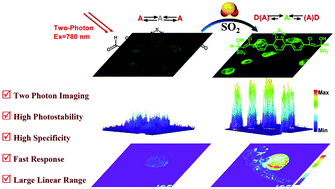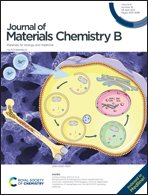A photostable reaction-based A–A–A type two-photon fluorescent probe for rapid detection and imaging of sulfur dioxide†
Abstract
In this study, a novel reaction-based A–A–A (acceptor–acceptor–acceptor) type two-photon fluorescent probe, BTC, is prepared using the benzothiadiazole (BTD) scaffold as the two-photon fluorophore and electron-accepting centre. Two β-chlorovinyl aldehyde moieties are symmetrically connected to both ends of the BTD scaffold and act as reaction groups to recognize SO2 and quenching groups to make the dis-activated probe stay at off-state due to their weak electron-withdrawing effect. In the presence of SO2 derivatives, the aldehyde groups are consumed through aldehyde addition, resulting in the activation of intramolecular charge transfer (ICT) processes and therefore recovering the fluorescence of the probe. The designed probe shows excellent two-photon properties including large two-photon absorption cross-sections (TPA) of 91 GM and photostability. Beyond these, the BTC probe exhibits a fast response to SO2 within 30 s, high specificity without foreign interference and a broad detection range from 500 nM to 120 μM with a detection limit of 190 nM. The designed fluorescent probe is further applied to the two-photon imaging of exogenous and endogenous SO2 derivatives under different physiological processes in HeLa cells and zebrafish with satisfactory results. We believe that the proposed design strategy can be extended to fabricate versatile BTD-based two-photon fluorescent probes through molecular engineering for further applications in bioassays and two-photon imaging.



 Please wait while we load your content...
Please wait while we load your content...